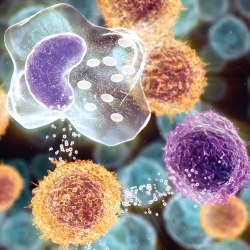
Ordinarily, when medical clinicians are conducting blood tests, it’s a somewhat elaborate affair. A full vial of blood must be drawn, individual portions of which are then loaded into large, expensive machines such as mass spectrometers. The results are usually quite accurate, but they’re not instantaneous, and require the services of trained personnel in a well-equipped lab. That may be about to change, however. Scientists from Houston’s Methodist Hospital Research Institute and MD Anderson Cancer Center have created a credit card-sized gadget, that can instantly check a single drop of blood for up to 50 different substances – and it costs about US$10.
Developed by a team led by Dr. Lidong Qin, the device is known as a volumetric bar-chart chip – or the V-chip, for short.
It consists of two thin sheets of glass, with a series of 50 tiny wells sandwiched between them. Each of those wells can contain different types of antibodies, selected for their tendency to bind to specific proteins. All of the wells also contain an enzyme known as catalase, along with hydrogen peroxide, and a dye. A sample drop of blood or other bodily fluid is placed in another well, at one end of the V-chip.
Initially, all of the wells are isolated from one another. When the two glass plates are slid against one another, however, the wells are linked by one long continuous zig-zagging microfluidic channel. The sample fluid flows along that channel, going through each of the wells as it does so.
When the antibodies in any one of the wells react with the targeted substance – such as insulin, or a specific drug or virus – the catalase is activated, which in turn splits the hydrogen peroxide into water and oxygen gas. That gas pushes the dye up a column linked to the well, where it can be seen by the user. The higher the dye goes in that column, the greater the amount of the substance in the sample. Viewed as a whole, the V-chip appears as a bar chart, indicating the relative amounts of the various targeted substances.
